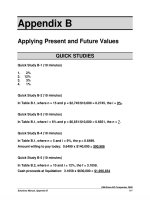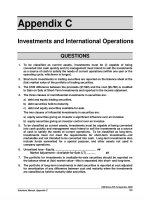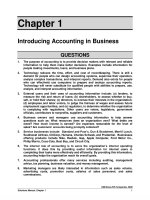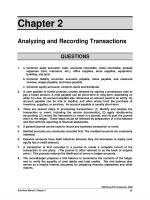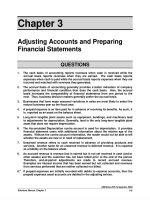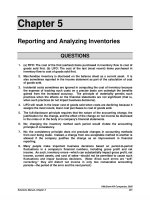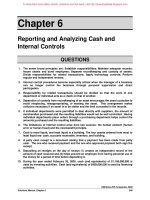Solution manual financial accounting by valix ch10 11
Bạn đang xem bản rút gọn của tài liệu. Xem và tải ngay bản đầy đủ của tài liệu tại đây (121.83 KB, 37 trang )
173
CHAPTER 10
Problem 10-1
Book value per share (8,800,000 / 50,000)
176
Problem 10-2
Excess
Ordinary
a. Balances
12% x 1,000,000 x 2
12% x 4,000,000
480,000
Balance for participation
3,000,000 1,000,000 4,000,000
(
240,000)
240,000
( 480,000)
2,280,000
Total
Divide by shares outstanding
40,000
Book value per share
157.60
b. Balances
12% x 1,000,000 x 2
15% x 4,000,000
600,000
Balance for participation
4% x 1,000,000
2,240,000
Total
Divide by shares
456,000
1,824,000
1,696,000 6,304,000
10,000
169.60
3,000,000 1,000,000 4,000,000
(
240,000)
240,000
( 600,000)
2,160,000
Total
Divide by shares
Book value per share
158.20
c. Balances
12% x 1,000,000 x 2
12% x 4,000,000
480,000
Balance for participation
Preference
432,000
1,728,000
1,672,000 6,328,000
10,000
40,000
167.20
3,000,000 1,000,000 4,000,000
(
240,000)
240,000
( 480,000)
2,280,000
40,000
1,280,000
10,000
6,720,000
40,000
Book value per share
168
128
174
Excess
Ordinary
d. Balances
12% x 1,000,000 x 2
To ordinary
2,760,000
3,000,000 1,000,000 4,000,000
(
240,000)
240,000
2,760,000 _________
Total
Divide by shares
Book value per share
169
e. Balances
12% x 1,000,000
To ordinary
2,880,000
Preference
1,240,000 6,760,000
10,000
40,000
124
3,000,000 1,000,000 4,000,000
(
120,000)
120,000
2,880,000 _________
Total
Divide by shares
Book value per share
172
1,120,000 6,880,000
10,000
40,000
112
Problem 10-3
Excess
Ordinary
a. Balances
4,000,000
12% x 2,000,000 x 3
To ordinary
(1,620,000)
Total
Divide by shares
( 900,000)
Preference
2,000,000
(
720,000)
(1,620,000)
720,000
_________
2,720,000
40,000
2,380,000
40,000
Book value per share
59.50
68
b. Balances
4,000,000
Prorata sharing
( 600,000)
( 900,000)
900,000
Total
Divide by shares
Book value per share
2,000,000
( 300,000)
1,700,000 3,400,000
40,000
40,000
42.50
85
175
Problem 10-4
Excess
Ordinary
Balances
Liquidation premium (40,000 x 3)
Preference dividend (12% x 2,000,000)
To ordinary
Total
Divide by shares
Book value per share
86.40
Preference
4,000,000 2,000,000 5,000,000
( 120,000)
120,000
( 240,000)
240,000
3,640,000 _________
3,640,000
2,360,000 8,640,000
40,000
100,000
59
In the absence of a contrary statement, the preference share is noncumulative
and nonparticipating.
Problem 10-5
6% Preference dividends (6% x 3,000,000 x 3 years)
540,000
8% Preference dividends (8% x 2,000,000)
160,000
Total preference dividends
700,000
Excess
6%
8%
over par
Ordinary
Preference as to assets:
Balances
5,000,000
Preference dividends
Balance to ordinary
( 170,000)
530,000
Preference
3,000,000
(700,000)
(170,000)
Total
4,830,000
Divide by shares outstanding
50,000
Book value per share
96.60
540,000
_________
Preference
2,000,000
160,000
_________
3,540,000
2,160,000
30,000
20,000
118
Preference as to dividends:
Balances
5,000,000
Prior years’ preference dividends
(6% x 3,000,000 x 2 years)
Balance
530,000
3,000,000
360,000
170,000
6% Preference (180,000 / 340,000 x 170,000)
8% Preference (160,000 / 340,000 x 170,000)
______
Total
5,000,000
Divide by shares outstanding
50,000
Book value per share
100
108
2,000,000
360,000
90,000
_________
80,000
3,450,000
2,080,000
30,000
20,000
115
__
104
176
Problem 10-6
Preference
Shares Amount
Amount
Issued
3,000,000
Add: Subscribed
500,000
Total
3,500,000
Less: Treasury
100,000
Issued and outstanding
3,400,000
Ordinary
Shares
15,000
1,500,000
30,000
2,000
200,000
5,000
17,000
1,700,000
35,000
1,000
100,000
1,000
16,000
1,600,000
34,000
1. Preference share capital
Share premium
Treasury preference share
100,000
10,000
2. Ordinary share capital
Treasury ordinary share
Share premium
100,000
110,000
70,000
30,000
Share premium (300,000 – 10,000 + 30,000)
Retained earnings unrestricted
Retained earnings appropriated
680,000
Total excess over par
1,968,000
320,000
968,000
Excess
Ordinary
Balances
3,400,000
12% x 1,600,000 x 5
12% x 3,400,000
408,000
Balance for participation
1,968,000
Preference
1,600,000
(
960,000)
( 408,000)
960,000
600,000
16 / 50 x 600,000
34 / 50 x 600,000
408,000
Total
4,216,000
Divide by shares outstanding
34,000
Book value per share
124
192,000
_________
2,752,000
16,000
172
Problem 10-7
Total shareholders’ equity
Less: Preference shareholders’ equity:
Preference share capital
Preference dividends (8% x 1,000,000 x 2)
1,160,000
Ordinary shareholders’ equity
2,660,000
3,820,000
1,000,000
160,000
177
Book value per share:
Preference (1,160,000 / 10,000 shares)
116
Ordinary (2,660,000 / 20,000 shares)
133
Ordinary shares issued
Less: Treasury shares
2,000
Outstanding ordinary shares
22,000
20,000
Problem 10-8
Ordinary issued
2,000,000
Subscribed
Total
Less: Treasury
500,000
Outstanding
Shares
20,000
Amount
10,000
30,000
5,000
1,000,000
3,000,000
25,000
2,500,000
Share premium (300,000 + 100,000 gain on treasury share)
400,000
Retained earnings
Total excess
Excess
Ordinary
Balances
2,500,000
12% x 1,500,000 x 3
12% x 2,500,000
300,000
Balance for participation
15 / 40 x 1,600,000
25 / 40 x 1,600,000
1,000,000
Total
3,800,000
Divide by shares outstanding
25,000
Book value per share
152
2,440,000
2,040,000
2,440,000
Preference
1,500,000
(
540,000)
( 300,000)
540,000
1,600,000
600,000
_________
2,640,000
15,000
176
Problem 10-9
1. Annual preference dividend (12% x 2,000,000)
240,000
Paid in 2007
Balance in 2007
40,000
Dividend in 2008
240,000
Total preference dividends in 2008
280,000
200,000
178
2. Total dividends paid in 2008
Less: Preference dividends paid in 2008
280,000
Ordinary dividends
320,000
600,000
Problem 18-10
1. Net income 2007 and 2008
1,610,000
Net loss 2004, 2005 and 2006
( 600,000)
Retained earnings – maximum dividend
1,010,000
2.
Balance
10% x 500,000
12% x 1,000,000 x 5
10% x 1,500,000
150,000
Balance
5 / 30 x 210,000
10 / 30 x 210,000
15 / 30 x 210,000
105,000
Total dividends
255,000
Retained
10%
12%
earnings
Preference
Preference Ordinary
1,010,000
(
50,000)
50,000
( 600,000)
600,000
( 150,000)
210,000
35,000
______
85,000
70,000
_______
670,000
Problem 10-11
Preference dividend (15% x 2,500,000)
375,000
Ordinary dividend (200,000 x 5)
1,000,000
Maximum dividend
1,375,000
Problem 10-12 Answer D
Total shareholders’ equity
Preference shareholders’ equity:
Preference share capital
Preference dividends in arrears
Liquidation premium
3,250,000
Ordinary shareholders’ equity
7,000,000
Divide by ordinary shares outstanding
100,000
Book value per ordinary share
10,025,000
2,500,000
250,000
500,000
70.00
179
Problem 10-13 Answer B
Total shareholders’ equity
Preference shareholders’ equity:
Preference share capital
Preference dividends for 2000 (1,000,000 x 8%)
Liquidation premium (20,000 x 5)
1,180,000
Ordinary shareholders’ equity
2,720,000
Divide by ordinary shares outstanding
100,000
Book value per ordinary share
3,900,000
1,000,000
80,000
100,000
27.20
Problem 10-14 Answer B
Total shareholders’ equity
Preference shareholders’ equity:
Preference share capital
Liquidation premium (10,000 x 5)
1,050,000
4,950,000
1,000,000
50,000
Ordinary shareholders’ equity
3,900,000
Divide by ordinary shares outstanding
30,000
Book value per ordinary share
130
Problem 10-15 Answer A
Total shareholders’ equity
Preference shareholders’ equity:
Preference share capital
Preference dividend (500,000 x 8%)
540,000
Ordinary shareholders’ equity
1,068,000
Divide by ordinary shares
89,000
Book value per ordinary share
1,608,000
500,000
40,000
12
Ordinary shares issued
Less: Treasury shares
1,000
Outstanding
90,000
89,000
Problem 10-16 Answer B
Total dividend declared in 2008
Preference dividends:
In arrears on December 31, 2007
2008 (6% x 4,000,000)
360,000
Balance to ordinary share
440,000
120,000
240,000
80,000
180
Problem 10-17 Answer D
Preference share capital (30,000 x 100)
3,000,000
Preference dividend in 2007 (3,000,000 x 5%)
150,000
Preference dividend in 2008
Total preference dividends
300,000
Less: Preference dividend paid in 2008
150,000
100,000
Preference dividends in arrears – December 31, 2008
200,000
A dividend is not a liability until it is legally declared. Accordingly, the
preference dividends in arrears of P200,000 on December 31, 2008 shall be
disclosed only.
Problem 10-18 Answer C
Dividend
Ordinary
Balance
10% x 3,000,000
10% x 2,000,000
200,000
Balance for participation
1,000,000
( 300,000)
( 200,000)
Preference
300,000
500,000
3,000,000 / 5,000,000 x 500,000
2,000,000 / 5,000,000 x 500,000
200,000
300,000
_______
600,000
400,000
Problem 10-19 Answer C
Total shareholders’ equity
Preference shareholders’ equity:
Preference share capital (500 x P1,000)
Liquidation premium (500 x P400)
700,000
Ordinary shareholders’ equity
2,900,000
Divide by ordinary shares
Book value per ordinary share
3,600,000
500,000
200,000
5,000
580
181
Problem 10-20 Answer A
Preference share capital
1,000,000
Ordinary share capital
Retained earnings – 2008 net income
6,000,000
Total shareholders’ equity
Preference shareholders’ equity:
Preference share capital
Preference dividend (1,000,000 x 10%)
Liquidation premium (100,000 x 2)
1,300,000
Ordinary shareholders’ equity
8,700,000
Divide by ordinary shares
Book value per ordinary share
3,000,000
10,000,000
1,000,000
100,000
200,000
30,000
290
Problem 10-21 Answer A
Preference share capital
1,000,000
Liquidation premium – excess of liquidating value over par (20,000 x 5)
100,000
Preference dividend for current year only (1,000,000 x 12%)
120,000
Total preference shareholders’ equity
1,220,000
Divide by preference shares outstanding
20,000
Book value per preference share
61
Problem 10-22 Answer A
Excess
Ordinary
Balances
5,000,000
12% x 2,000,000 x 3
14% x 3,000,000 x 1
12% x 5,000,000 x 1
600,000
Balance – prorata
1,000,000
Total
Divide by shares outstanding
50,000
Book value per share
132
12% PS
3,740,000
2,000,000
( 720,000)
( 420,000)
( 600,000)
2,000,000
14% PS
3,000,000
720,000
420,000
400,000
600,000
3,120,000 4,020,000 6,600,000
20,000
10,000
156
420
The “excess” is the sum of the retained earnings and share premium.
Share capital
Allocation
12% Preference share
400,000
14% Preference share
600,000
Ordinary share
1,000,000
Fraction
2,000,000
2/10
3,000,000
3/10
5,000,000
5/10
10,000,000
2,000,000
182
Problem 10-23 Answer C
Preference share capital
Ordinary share capital
Subscribed ordinary share capital
Share premium
Retained earnings
Treasury shares
800,000)
Total equity
Preference shareholders’ equity:
Preference share capital
Preference dividend for 2006, 2007, 2008
(2,000,000 x 10% x 3)
2,600,000
Ordinary shareholders’ equity
8,000,000
2,000,000
4,000,000
2,000,000
1,000,000
2,400,000
(
10,600,000
2,000,000
600,000
For book value purposes, the subscription receivable is not deducted from
subscribed share capital in determining the total shareholders’ equity.
Ordinary shares issued
Ordinary shares subscribed
20,000
Total
Treasury shares
Ordinary shares outstanding
40,000
60,000
(10,000)
50,000
Book value per ordinary share (8,000,000 / 50,000)
160
Problem 10-24 Answer C
Dividends
Ordinary
Amount
900,000
Preference
6% x 1,000,000 x 3
6% x 4,000,000
240,000
Balance prorata
(180,000)
(240,000)
180,000
480,000
1/5 x 480,000
4/5 x 480,000
384,000
Total dividends
624,000
96,000
_______
276,000
Problem 10-25 Answer B
Total income 2007 and 2008
Total loss 2004, 2005 and 2006
(3,000,000)
Retained earnings – maximum dividend
5,000,000
8,000,000
183
Retained
earnings
Ordinary
Dividend
12% x 1,000,000
10% x 2,500,000 x 5
10% x 7,500,000
750,000
Balance for participation
2,160,000
Total dividend
2,910,000
12%
10%
Preference Preference
5,000,000
(
120,000)
(1,250,000)
(
750,000)
2,880,000
120,000
1,250,000
-___
120,000
720,000
1,970,000
Before participation, one year dividend is paid to ordinary share capital using
the participating preference rate. The balance for participation is disturbed
on a prorata basis as follows:
Amount
Allocation
10% Preference share
720,000
Ordinary share
2,160,000
2,500,000
7,500,000
10,000,000
2,880,000
Fraction
25/100
75/100
184
CHAPTER 11
Problem 11-1
1.
2.
3.
4.
5.
D
B
D
A
D
6.
7.
8.
9.
10.
A
B
B
B
A
Problem 11-2
11. D
12. A
13. B
14. A
15. B
1. C
2. B
3. B
4. B
5. A
6. B
7. A
8. A
9. C
10. A
Problem 11-3
1. Basic earnings per share:
Income from continuing operations (3,400,000 / 50,000)
Loss from discontinued operations (600,000 / 50,000)
(12)
Net income
2. Basic earnings per share:
Income from continuing operations
Less: Preference dividend (10% x 2,000,000)
200,000
68
56
3,400,000
Income to ordinary share
3,200,000
Income from continuing operations (3,200,000 / 50,000)
Loss from discontinued operations
(12) Net income
64
52
Problem 11-4
1.
Date
January
1
June
1
September 30
Shares
120,000
12,000
( 24,000)
Fraction
12/12
7/12
3/12
Average
120,000
7,000
( 6,000)
121,000
2. Basic earnings per share (3.630,000 / 121,000)
30
Problem 11-5
1.
Date
January 1
April
1
Shares
120,000
20,000
Fraction
12/12
9/12
Average
120,000
15,000
135,000
185
2. Income from continuing operations
Less: Preference dividend actually paid
Income to ordinary share
3,765,000
120,000
3,645,000
Basic earnings per share:
Income from continuing operations (3,645,000 / 135,000)
27
Loss from discontinued operations (540,000 / 135,000)
( 4)
Net income per share
23
Problem 11-6
Date
1. January
May
July
December
1
1
1
1
Shares
150,000
30,000
12,000
6,000
Months
12
8
6
1
Average shares (1,974,000 / 12)
Peso months
1,800,000
240,000
(
72,000)
6,000
1,974,000
164,500
2. Net loss
(2,690,000)
Preference dividend (12% x 5,000,000)
( 600,000)
Total loss to ordinary share
(3,290,000)
Basic loss per share (3,290,000 / 164,500)
(20)
Problem 11-7
Date
1. January
May
July
1
1
1
Shares
1,000,000
120,000
48,000
Months
12
10
2
Peso months
12,000,000
1, 200,000
(
96,000)
13,104,000
Average shares (13,104,000 / 12)
1,092,000
2. Net income
Less: Preference dividend (10% x 4,000,000)
400,000
Adjusted income to ordinary share
5,460,000
5,860,000
Basic earnings per share (5,460,000 / 1,092,000)
5
186
Problem 11-8
1. Basic earnings per share (1,735,000 / 50,000)
34.70
2. Ordinary shares outstanding
50,000
Assumed issued ordinary shares through bond conversion (1,000 x 10)
10,000
Total ordinary shares
60,000
Net income
Add: Interest on bonds payable (10% x 1,000,000 x 65%)
65,000
Adjusted income
1,735,000
1,800,000
Diluted EPS (1,800,000 / 60,000)
30
Problem 11-9
1. Net income
Less: Preference dividend (10% x 5,000,000)
500,000
Adjusted income to ordinary share
4,900,000
Basic EPS (4,900,000 / 200,000)
2. Ordinary shares outstanding
200,000
Assumed issued ordinary shares through bond conversion
of preference share (50,000 x 2)
100,000
Total ordinary shares
5,400,000
24.50
300,000
Diluted EPS (5,400,000 / 300,000)
18
Problem 11-10
1. Net income
Less: Preference dividend (12% x 3,000,000)
360,000
Net income to ordinary share
3,342,500
Basic EPS (3,342,500 / 100,000)
2. Net income
Add: Interest on bonds payable (1,500,000 x 10% x 65%)
97,500
Adjusted income
3,702,500
33.42
3,702,500
3,800,000
187
Ordinary shares outstanding
Assumed issued ordinary shares through bond conversion
(1,500 x 20)
Assumed issued ordinary shares through conversion of
preference (30,000 x 2)
60,000
100,000
30,000
Total ordinary shares
190,000
Diluted EPS (3,800,000 / 190,000)
20
Note:
Incremental EPS on BP (97,500 / 30,000)
Incremental EPS on PS (360,000 / 60,000)
6.00
3.25
Both the BP and PS are potentially dilutive because the incremental EPS is very
much lower than the basic EPS.
Problem 11-11
1. Net income
Less: Preference dividend (20,000 x 5)
100,000
Net income to ordinary share
2,320,000
2,420,000
Basic EPS (2,320,000 / 100,000)
23.20
2. Net income
Add: Interest on bonds payable (2,000,000 x 10% x 65%)
130,000
Adjusted income
2,420,000
2,550,000
Ordinary shares outstanding
100,000
Assumed issued ordinary shares through bond conversion
30,000
Assumed issued ordinary shares through preference share conversion
40,000
Total ordinary shares
170,000
Diluted EPS (2,550,000 / 170,000)
15
Problem 11-12
1. Basic EPS (2,758,000 / 100,000)
27.58
188
2. Ordinary shares outstanding
Assumed issued ordinary shares through bond conversion
(2,000 x 10 = 20,000 x 9/12)
15,000
Total ordinary shares
Net income
Add: Interest on bonds (12% x 2,000,000 x 9/12)
Less: Income tax – 35%
117,000
Adjusted income
100,000
115,000
2,758,000
180,000
63,000
2,875,000
Diluted EPS (2,875,000 / 115,000)
25
Problem 11-13
1. January 1 (100,000 x 12)
1,200,000
April
1 (3,000 x 20 = 60,000 x 9)
540,000
1,740,000
Average (1,740,000 / 12)
145,000
Basic EPS (2,320,000 / 145,000)
16
2. Ordinary shares outstanding
100,000
Ordinary shares issued through actual bond conversion (3,000 x 20)
60,000
Assumed ordinary shares issued through conversion of remaining
bonds (1,000 x 20)
20,000
Total ordinary shares
180,000
Since the bonds are outstanding on January 1, 2008, the ordinary shares
issued through the actual bond conversion are considered outstanding from
January 1, 2008.
Net income
Add: Interest on bonds actually converted
(3,000,000 x 12% x 3/12)
Interest on remaining bonds (1,000,000 x 12%)
2,320,000
90,000
120,000
Total
Less: Income tax – 35%
136,500
Adjusted income
210,000
73,500
2,456,500
Diluted EPS (2,456,500 / 180,000)
13.65
189
Problem 11-14
1. Basic EPS (7,500,000 / 200,000)
37.50
2. Total option price (50,000 x 60)
Ordinary shares actually outstanding
200,000 Incremental ordinary shares:
Option shares
Less: Assumed treasury shares (3,000,000 / 75)
10,000 Total ordinary shares
210,000
3,000,000
50,000
40,000
Diluted EPS (7,500,000 / 210,000)
35.71
Problem 11-15
1. Basic EPS (3,000,000 / 60,000)
50
2. Total option price (20,000 x 160)
3,200,000
Option shares
Less: Assumed treasury shares (3,200,000 / 250)
12,800 Incremental ordinary shares
7,200 Multiply by (9 months)
9/12
Average incremental shares
Ordinary shares actually outstanding
Total
Diluted EPS (3,000,000 / 65,400)
Problem 11-16
20,000
5,400
60,000
65,400
45.87
1. January 1 Beginning balance
April
1 (50,000 x 9/12)
Total ordinary shares
100,000
37,500
137,500
Basic EPS (5,500,000 / 137,500)
40
2. Proceeds from assumed exercise of options (50,000 x 140)
7,000,000
190
January 1
Beginning balance
April
1
(50,000 x 9/12)
Incremental ordinary shares:
Option shares
Less: Assumed treasury shares (7,000,000 / 400)
Incremental shares
Weighted average (32,500 x 3/12)
8,125
Total ordinary shares
100,000
37,500
50,000
17,500
32,500
145,625
Diluted EPS (5,500,000 / 145,625)
37.77
Problem 11-17
1. Net income
Less: Preference dividend (10,000 x 30)
300,000
Adjusted income
January
1 Beginning balance
September 1 (60,000 x 4/12)
20,000
6,700,000
6,400,000
300,000
320,000
Basic EPS (6,400,000 / 320,000)
2. Net income
Less: Preference dividend
Balance
Add: Interest on bonds (1,000,000 x 10%)
Less: Income tax 35%
65,000
Adjusted income
20
6,700,000
300,000
6,400,000
100,000
35,000
6,465,000
Proceeds from assumed exercise of options (30,000 x 25)
750,000
January
1 Balance
300,000
September 1 Issued (60,000 x 4/12)
20,000
Assumed issued ordinary shares through bond conversion
(1,000 x 40)
40,000
Incremental ordinary shares:
Option shares
30,000
Less: Assumed treasury shares (750,000 / 30)
25,000
5,000
Warrants to purchase 20,000 ordinary shares – antidilutive
because the exercise price is higher than the average
market price
-___
Total ordinary shares
365,000
191
Diluted EPS (6,465,000 / 365,000)
17.71
Problem 11-18
Ordinary shares – 12/31/2008
200,000
Bonus issue (200,000 x 2)
400,000
Total shares outstanding – 12/31/2009
600,000
Basic earnings per share:
2008(18,000,000 / 600,000)
30.00
2009(60,000,000 / 600,000)
100.00
Problem 11-19
1. Market value of ordinary shares outstanding (600,000 x 11)
6,600,000
Proceeds from exercise of rights (120,000 x 5)
600,000
Total
Shares outstanding
7,200,000
600,000
Shares issued through exercise of rights
120,000
Total shares outstanding
720,000
Theoretical value of stock ex-right (7,200,000 / 720,000)
10
2. Adjustment factor (11/10)
1.10
3. 2008
Shares outstanding
Adjustment factor
Adjusted shares
660,000
600,000
1.10
Basic EPS (11,000,000 / 660,000)
16.67
2009
January 1
110,000
March 1
Total
(600,000 x 1.10 x 2/12)
(720,000 x 10/12)
600,000
710,000
Basic EPS (15,000,000 / 710,000)
21.13
2010
Basic EPS (18,000,000 / 720,000)
25.00
192
Problem 11-20
1. Ordinary shares – 01/01/2008
1,000,000
April 1 (50,000 x 9/12)
July 1 (50,000 x 6/12)
Total
Basic EPS (5,900,000 / 1,062,500)
5.55
2. Ordinary shares – 01/01/2008
1,000,000
37,500
25,000
1,062,500
April 1 – new branch
50,000
July 1 – new branch
50,000
December 31 – net income in excess of P5,000,000 (900 x 1,000)
900,000
Total
2,000,000
Diluted EPS (5,900,000 / 2,000,000)
2.95
Problem 11-21 Answer A
Net income
Less: Preference dividend
Net income to ordinary share
630,000
750,000
120,000
Basic EPS (630,000 / 60,000)
10.50
Problem 11-22 Answer A
January 1
120,000
June
30
30,000
150,000
80,000 + 40,000
40,000 + 20,000 x 6/12
Average shares
Basic EPS (2,400,000 / 150,000)
16
Problem 11-23 Answer C
January 1
396,000
March 1
90,000
July
1
48,000
33,000 x 12 months
9,000 x 10 months
8,000 x 6 months
534,000
Average number of shares (534,000 / 12)
44,500
193
Problem 11-24 Answer C
January 1 300,000 + 30,000 x 12 months
3,960,000
October 1
24,000 x 3 months
(
72,000)
3,888,000
Average number of shares (3,888,000 / 12)
324,000
Problem 11-25 Answer B
January 1
100,000 x 2 x 1.20
June 1
30,000 x 1.20 x 7/12
Average number of shares
240,000
21,000
261,000
Problem 11-26 Answer B
January 1 (100,000 x 2 x 1.20 x 3)
April 1
(30,000 x 2 x 1.20 x 3 x 9/12)
162,000
June 30 (10,000 x 1.20 x 3 x 6/12)
( 18,000)
Average shares
720,000
864,000
Problem 11-27 Answer A
January 1
(44,000 x 1.25 x 3)
1,650,000
February 1
(56,000 x 1.25 x 3 x 11/12)
192,500
May 1
(25,000 x 1.25 x 3 x 8/12)
62,500)
September 1
(10,000 x 3 x 4/12)
10,000
Average shares
(
305,000
Problem 11-28
Question 1 Answer A
2008
January 1
900,000
March 1
October 1
December 1
3,750)
(250,000 x 1.20 x 3)
(24,000 x 1.20 x 3 x 10/12)
(16,000 x 3 x 3/12)
(15,000 x 3 x 1/12)
72,000
12,000
(

